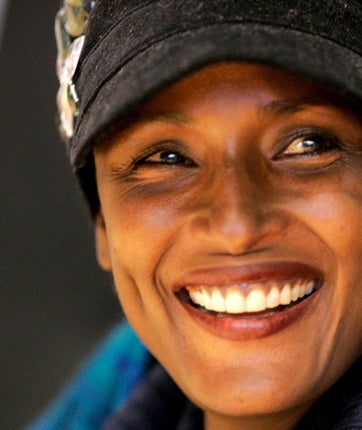The supermodel from Somalia
Threatened with an arranged marriage when she was 13, Waris Dirie fled to London where she was working illegally as a cleaner before being spotted by a photographer. Arifa Akbar reports on the film that tells the extraordinary story

It is the story of a girl born to a clan of nomadic goat herders in Somalia who flees her remote village at the age of 13 when she discovers her family have arranged for her to be the fourth wife of a man more than twice her age.
She travels from Mogadishu to London where she works illegally as a cleaner until she is "discovered" by a fashion photographer, and propelled into a life of international fame and fortune.
So reads the true story of Waris Dirie, a former supermodel and face of Revlon who also appeared in the James Bond movie, The Living Daylights.
Yesterday, Dirie was at the Venice Film Festival to unveil Desert Flower, a film about her life, named after her internationally bestselling biography. The film, which has already received critical acclaim, stars some of Britain's best character actors including Sally Hawkins, Timothy Spall, Juliet Stevenson and the comedy writer, Meera Syal. Dirie is played by Liya Kebede, an Ethiopian model who was in Robert De Niro's The Good Shepherd.
Speaking about the making of Desert Flower yesterday, Dirie, who now lives in Austria, said she wanted the film to focus on the secret which she revealed at the height of her modelling career in 1997, that she had suffered genital mutilation at the age of five.
The revelation transformed her into the "face of female genital mutilation", she said. "Before I spoke about it, no-one talked about female genital mutilation. I felt divided. There was half of me that said 'go ahead, I can handle it', and the other half said 'no'. I never thought I would get this far."
But it sparked an astonishing global response. She became a human rights campaigner, a UN special ambassador and received numerous humanitarian awards, including the French Chevalier de la légion d'honneur in 2007.
The film's director, Sherry Hormann, said she made a promise to Dirie that "the mutilation scene would be in the script" and that the film "would entertain as well as move people".
Hormann decided to make the film in Djibouti, which borders Somalia and Ethiopia. Desert Flower's subject matter upset some of the local people there. Genital mutilation is still a custom in some communities. "Hundreds of police had blocked the [marketplace] area for the shoot but then, all of a sudden, they all disappeared. Chaos broke out, members of the crew were being attacked with stones," she said.

Watch Apple TV+ free for 7 day
New subscribers only. £9.99/mo. after free trial. Plan auto-renews until cancelled.
ADVERTISEMENT. If you sign up to this service we will earn commission. This revenue helps to fund journalism across The Independent.

Watch Apple TV+ free for 7 day
New subscribers only. £9.99/mo. after free trial. Plan auto-renews until cancelled.
ADVERTISEMENT. If you sign up to this service we will earn commission. This revenue helps to fund journalism across The Independent.
However, Dirie said it was vital that the mutilation scene was shot close to where it had happened to her; although seeing it re-enacted in front of her was a painful experience. "That moment when I sat and watched the filming [of the mutilation] brought me back my whole life. It felt as if that part of it was real," she said. As the crew finished filming the scene, two women ran to them screaming and said they had just passed a bloodied rock where young girls had been mutilated. "As we were filming it [the mutilation], it was happening there," said Dirie.
Hormann was determined to film Dirie's life story as authentically as possible. She used local families as extras in the film as well as a real circumciser. "In Djibouti, I realised that Desert Flower would become the first film to focus on Somali culture and its Islamic roots. We filmed nomads who had never seen a camera before. We took the risk to get a real circumciser who was willing to allow herself to be filmed."
The director also shot scenes in London with a hidden camera, in which Kebede roamed among the homeless people in Soho. Kebede, who in 2007 was the 11th highest-paid model in the world, according to Forbes, said she was mistaken for a real homeless person. She said: "We filmed at 3 or 4 in the morning. I was in a pink jilbad [traditional Somali dress], and Sherry was hiding. I had a microphone in my ear and the camera was hidden ... A couple of Somali guys came up to me and said 'are you OK?'"
She said prior to being cast in the film, she had read about Dirie's "extraordinary life story" and sought to portray her courageous, campaigning spirit as faithfully as possible.
Dirie said seeing the film was emotionally difficult – "I don't think I could see it again, it hurt me". However, she hopes it will expose and help stop the brutal practice of female genital mutilation. "I want the movie to make a change. I know the world knows it's wrong ... I have to think of the children of tomorrow. I want to say 'don't touch them ... I'm coming.'"
Join our commenting forum
Join thought-provoking conversations, follow other Independent readers and see their replies
Comments
Bookmark popover
Removed from bookmarks